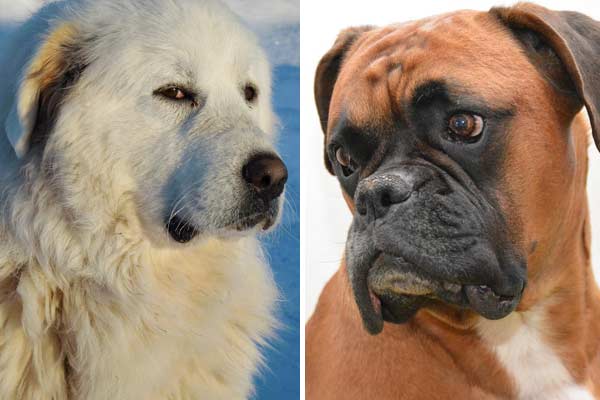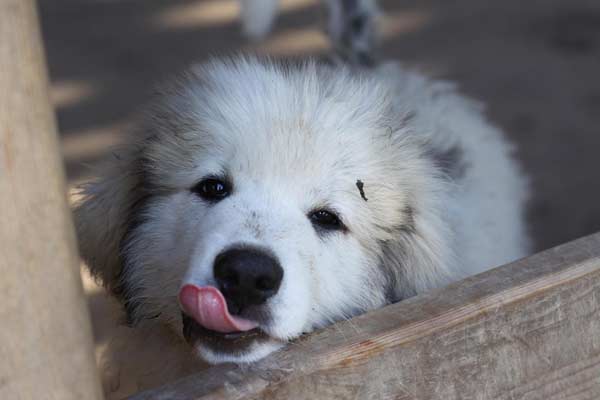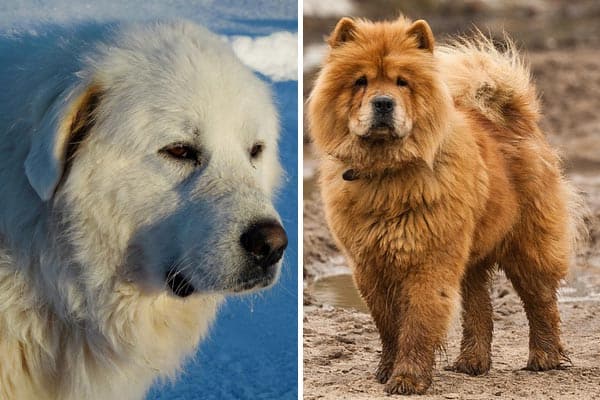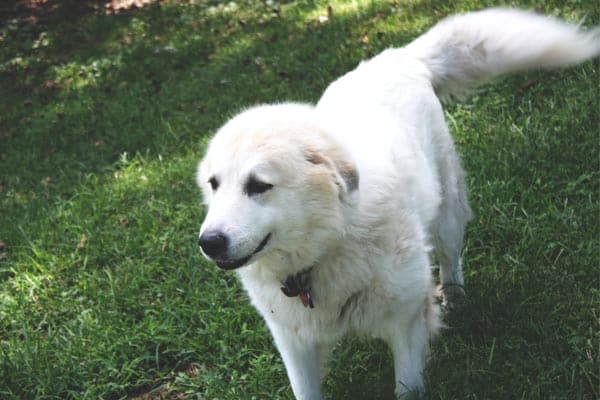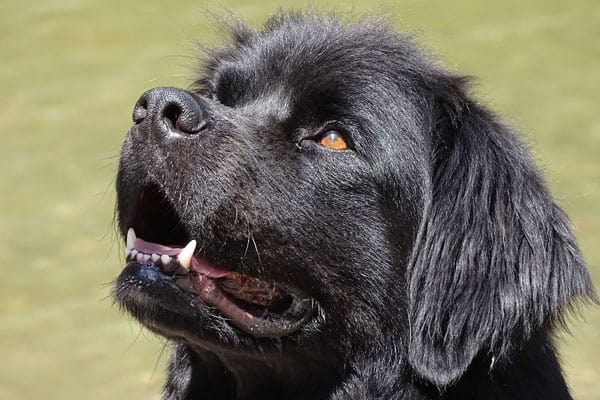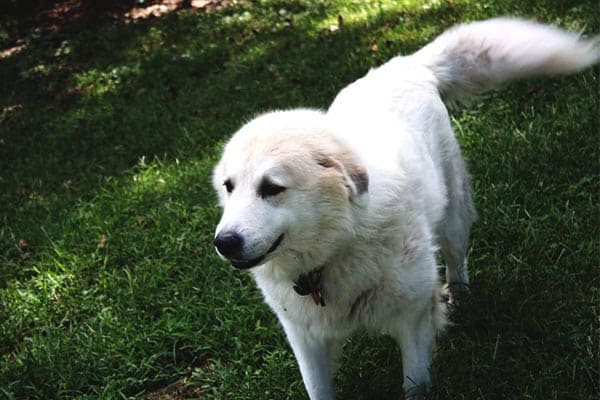Newfoundland vs Great Pyrenees: Water Rescue vs Sheep Guarding
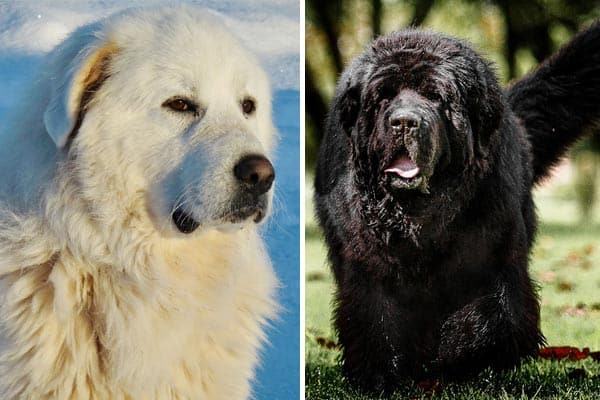
When you look at a Newfoundland vs Great Pyrenees, are you seeing just a black and white variation of the same dog? Intuitively, you probably spot many differences, but can you describe them?
The Newfoundland vs Great Pyrenees is a black heavy-set dog with a brushtail and heavy square-shaped head. This contrasts the Great Pyrenees’ roughly triangular head, white coat, and heavily-plumed tail.
The Great Pyrenees also has a longer snout and is taller and slightly heavier. Finally, Newfoundland is a renowned water rescue dog while the Great Pyrenees is a livestock guardian dog.
Is Newfoundland larger than Great Pyrenees?
Newfoundlands are about 26 to 30 inches tall at the top of the withers and weigh 100 to 150 pounds. Females are smaller with much less heaviness of bone and muscle than males.
A female Great Pyrenees is 25 to 29 inches tall at the shoulders while a male ranges from 29 to 32 inches high. Great Pyrenees dogs weigh anywhere between 80 and 160 pounds with females at the lower parameters.
The Great Pyrenees is slightly bigger than Newfoundland. What you will notice is that the Great Pyrenees appears leggier and has a much wider weight range.
What is Newfoundland vs Great Pyrenees breed standard?
Newfoundlands and Great Pyrenees have several differences that go beyond coat colors. The Newfoundland is not quite as tall as the Great Pyrenees and is bigger-boned with a larger head.
Moreover, Newfoundland’s ears are set slightly higher and a little more forward than the Great Pyrenees. The eyes are relatively smaller and set wider apart in Newfoundland because of the broader skull.
Head
Newfoundland
- Skull massive
- Stop moderate – well-developed brow makes stop appear to have a more abrupt angle
- Cheekbones well-developed
- Eyes – small, wide-spaced, deep-set
- Ears – small and triangular with rounded tips
- Muzzle – broad and deep, shorter than the length of back skull
- Head carriage proud – neck rather long but powerful and in balance with rest of body
Great Pyrenees
- Skull medium in size and wedge-shaped, broad between the ears and tapering gradually to the nose; nose should not end in a point
- Stop moderate – well-developed brow makes stop appear to have a more abrupt angle
- Cheekbones flat but filled-in
- Eyes – medium-sized, almond-shaped, dark
- Ears – small or medium-sized, V-shaped, rounded tips; set low at eye level and lie close to the head; abutting hair of lower and upper face create characteristic demarcation from outer eye corner to the ear’s base
- Muzzle – the same length as the back skull, tight lips
- Head carriage regal – neck medium in length and powerful
Body
Newfoundland
- Back – broad and strong
- Topline – level
- Chest – full, deep
- Croup – broad, slightly sloping
Great Pyrenees
- Back – broad, strong
- Topline – level
- Chest – moderately broad and deep
- Croup – broad, slightly sloping
Legs
Newfoundland
- Shoulders – well laid back (angle of the shoulder blade from the humerus is generous to allow good forward reach)and muscular
- Elbows line up below the point of withers
- Forelegs – heavy bone and muscle, straight
- Feet – cat-shaped, webbed
- Hindlimbs – heavy bone, well-muscled, broad thigh bones; dewclaws removed
Great Pyrenees
- Shoulders – muscular, well laid back (angle of the shoulder blade from the humerus is generous to allow good forward reach)
- Elbows line up directly below withers
- Forelegs – in balance with the rest of the body
- Feet – well-padded and close-cupped (compact, cat-like with arched toes); rear feet toe out slightly
- Hindlimbs – Bone and muscle in balance with the rest of the dog’s body; muscular thighs; double dewclaws on both hind legs
Tail
A Newfoundland has a tail set in line with her croup, and the appendage should have no kinks. The tail hangs straight to the hocks when the dog is in a relaxed posture. During work or excitement, the Newfoundland’s tail comes up but does not curl over the back.
The Great Pyrenees’ tail also hangs to the hoicks but may have a shepherd’s hook at the end. At rest, it hangs, sometimes with a slight curve upward at the end.
During movement or when alert, the Great Pyrenees’ tail often forms a wheel over the back. It is distinguishable by its luxurious plumes.
Coat
Newfoundland
- Water-resistant and flat
- Outer – medium-long, full, straight or wavy,
- Undercoat – soft but dense; climate variable, significantly thinner in warm climates
- Feathering on backs of legs upper and lower
- Face and snout – short, fine fur
- Colors – black, gray, brown, or Landseer (white with black markings); all solid colors may have white markings in stereotypical places (chest, chin, toes, and tail tip); gray and brown dogs can have light-colored furnishings; brown or black dogs can have a bronze tint
Great Pyrenees
- Weather-resistant and should lie flat
- Outer – medium-long, full, straight or slight waves, coarse; ruff or mane of longer fur around neck and shoulders
- Undercoat – soft dense wool
- Feathering on backs of forelimbs, feathering called pantaloons on backs of upper thighs
- Face, ears, and snout – shorter, finer fur
- Colors – solid white, white with badger, gray, tan, reddish-brown, or red markings on ears, face like a broken or complete mask, and tail; occasionally, a few markings also show up on the body, but colors other than white should not make up more than 33% of the coat
The Newfoundland vs Great Pyrenees temperament befits a rescue dog
Sweet is rarely part of the breed standard of a working dog, so you may find it surprising that a Newfoundland should be just that.
According to the AKC, the disposition of a Newfoundland is more important than other characteristics. However, Newfoundland must carry his calm nature and friendliness with dignity.
Other Newfie qualities are loyalty, intelligence, gentleness, a strong work ethic, and a small degree of independence.
Newfies are excellent with people, children, and other dogs if they have a proper upbringing of plentiful attention and intense socialization.
With maturity, they gain the patience and low activity to play with small children. Of course, you must supervise any child under the age of 10 years with such a large dog.
When young, Newfoundlands can be too rambunctious around toddlers.
With their affable natures, Newfies also get along with other dogs of all breeds. A few individual males may show same-sex aggression. Again, use caution when mixing Newfies and Toy or small-breed dogs. Newfoundlands tend to get along with cats.
Your Newfoundland can prove somewhat protective of you but should never exhibit viciousness or shyness. Watchful dogs, Newfies may or may not bark to warn of visitors or intruders.
Nevertheless, their imposing size is usually intimidating to ward off trespassers even with their pleasant expressions.
Great Pyrs can also be gentle and calm but are protective and reserved. Protectiveness may extend to children as well as the livestock the Great Pyrenees is tasked with guarding.
As guardians, Great Pyrenees take their duties seriously and become formidable against not only classic predators like wolves and coyotes but also against strange people, unfamiliar kids, and other dogs.
Well-socialized dogs that are off duty should not be aggressive towards people and typically get along with other dogs.
Great Pyrs exhibit a calmness and patience commendable in such a large dog. They tend to wander and will try to escape from fenced-in yards. Unsocialized dogs may display shyness or misplaced aggression and can prove dangerous to livestock.
Why do Pyrs live longer than Newfies?
The Great Pyrenees has a longer life expectancy than Newfoundland and does not suffer as much from some of the common large-breed ailments like hip dysplasia.
Newfoundland Health Challenges
- Lifespan – 8 to 10 years
- Hip dysplasia (25.8% as of 2020)
- Elbow dysplasia (over 23% as of 2020)
- Bloat or GDV (gastric dilatation and volvulus)
- Subaortic stenosis –
- Cataracts
- OCD – cartilage abnormalities leading to painful joints and arthritis
- von Willebrand’s – clotting disorder
- Epilepsy – seizure disorder
- Hot spots – weepy skin sores; can appear under matted hair
- Entropion – eyelids roll inward, the hairs irritating the eye
- Dilated cardiomyopathy – a genetic condition whereby the heart muscle is weak, leading to ineffectual contractions and overfilling; heart walls become thin and heart enlarged; can cause sudden death from arrhythmia or eventually results in congestive heart failure
Great Pyrenees Health Issues
- Lifespan – 10 to 12 years
- Hip dysplasia (9.4% as of 2020)
- OCD
- Osteosarcoma – bone cancer
- Ear infections
- Degenerative myelopathy – progressive neurologic disorder; recessive gene; over 11% of dogs may carry the disease
- Panosteitis – inflammation in long bones of growing puppies
- Chondrodysplasia – growth abnormality of cartilage, can lead to OCD
- Luxating patella – kneecap will not stay in position
- Spinal muscular atrophy – similar symptoms as degenerative myelopathy but carried on a dominant gene; nerves to spinal cord die, leading to muscle wasting and loss of coordination and ability to walk
- Deafness
What is the basic care of Newfoundland vs Great Pyrenees?
Newfies and Pyrs, as you would expect, have similar care requirements.
- Brush coat 2 or 3 times weekly – pin brush, undercoat rake, slicker
- Check ears 3 times weekly
- Brush teeth every two days
- Trim nails every 6 weeks
- Food – 18 to 22 calories per pound of body weight per day, puppies two or three times as much; feed even adults at least twice daily; animal proteins and high-quality fats or oils essential
- Exercise – 40 to 60 minutes per day; mental stimulation, ideally a job, crucial
- Training – repetition and positive reinforcement and meaningful correction; Newfoundland easier for beginners than Great Pyrenees
- Intelligence – high but independent and stubborn; Great Pyrenees (#64 working intelligence) more independent and strong-willed, Newfie (#34 rank in working intelligence) typically more eager to please; ranking out of over 80 breeds
- Excellent in cold weather; need shelter from heat and humidity; Newfie more tolerant of cold rain, Great Pyr more tolerant of snow and heat
Where did it start for the Newfie vs Great Pyr?
Newfoundland originated off the coast of Canada. Its ancestors helped retrieve large fishing nets and other gear from off ships in Newfoundland.
Eventually, the dogs found a use for rescuing humans from the treacherous and often icy waters.
On land, they had renowned strength for hauling supplies. They may have existed in Canada as early as 1000 AD, but the development of the Newfoundland breed began in earnest in England from 1775 onwards from exports.
The Great Pyrenees likely contributed to the Landseer color variety. Newfoundland joined the AKC in 1886.
The Great Pyrenees or Pyrenean Mountain Dog is an ancient breed that developed in France. Its primary purpose was to guard sheep against mountain predators such as wolves, bears, and cougars.
It is an ancient dog of perhaps 3000 BC whose development occurred in relative isolation alongside Spain’s border.
In the 1600s the dog’s duties expanded to estate guarding under Louis XIV. The AKC recognized the Great Pyrenees in 1933 with a breed standard revision in 1990.
Video
You can immediately see several differences between the Newfoundland and Great Pyrenees in this video.
The Great Pyrenees appears taller because it is likely it is but also does not have such thick legs, The snout is relatively longer, and the ears have a different shape.
Notice the luxurious plemes on the Pyr’s tail and how it is carried in a circle over the back.
